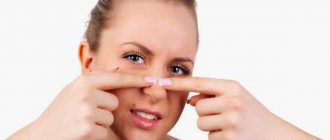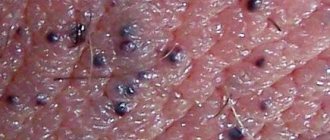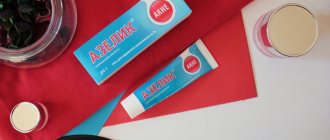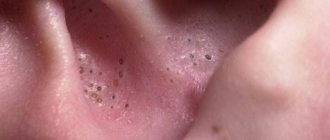Comedones (blackheads) - symptoms and treatment
The formation of comedones is based on disruption of the normal functioning of the sebaceous glands. They are located in the deep layers of the skin, at the root of the hair.
The sebaceous glands produce their own secretion - sebum, or sebum. Moving up the pilosebaceous duct, it creates a protective barrier on the skin, gives it elasticity, maintains a normal pH level, and helps retain moisture.
The cells that produce sebum are constantly renewed: they shift towards the mouth of the sebaceous gland, gradually accumulate secretion and are destroyed. The keratinocytes that line the exit duct of the follicle are also constantly renewed and exfoliated.
When the function of the sebaceous glands is disrupted, the following happens:
- The sebaceous glands begin to produce too much sebum. It turns into a thick sticky mass that completely fills the duct.
- The formation of keratinocytes intensifies, and there are more cells. They get stuck in thick sebum and clog the outlet duct of the sebaceous gland.
When the lumen of the canal is completely filled, the contents of the pilosebaceous duct begin to press on the walls of the canal. The mouth of the duct expands, eventually forming a comedon. In such an environment, opportunistic flora is activated over time. She begins to absorb excess sebum, which is a nutrient medium for her. As a result, the pilosebaceous follicle becomes inflamed and acne develops [3].
Heredity, hormonal disorders and nutrition
A genetic predisposition to comedones may be associated with one of four characteristics:
- large sebaceous gland;
- hypersensitivity of sebaceous gland receptors to sex hormones - androgens;
- hyperandrogenism - high levels of androgens;
- increased activity of the enzyme 5-alphareductase with normal levels of sex hormones.
The last feature is associated with the transition of androgen to dihydrotestosterone - DHT. This transition occurs under the influence of the enzyme 5-alphareductase.
DHT controls the activity of the sebaceous glands and the process of keratinization. This hormone binds to androgen receptors in a “lock and key” manner, where the “key” is the hormone and the “lock” is the androgen receptor. But “opening the lock” can only be done with the help of another hormone—insulin or insulin-like growth factor—IGF-1 [3].
Insulin and glucose themselves are necessary for the body. Their level increases after eating any food. But with excessive amounts of sweets, refined and other foods, the concentration of insulin and glucose becomes greater. Moreover, the level of glucose in the blood increases first, and then insulin. And then everything develops according to the same scenario, leading to the active production of sebum and the formation of comedones.
Insulin levels also increase when eating whole milk products. Insulin binds to androgen receptors and increases DHT levels. This hormone, in turn, binds to the receptors of the sebaceous glands and stimulates the production of sebum.
Therefore, people who are genetically prone to increased sebum secretion should be especially careful and control the consumption of sweets, dairy and refined products.
Improper skin care
Skin prone to the development of comedonal acne needs proper care.
Soap, harsh scrubs and alcohol products with surfactants only injure the skin, leading to the appearance of new comedones. These products disrupt the skin's pH, its protective barrier, causing it to become overdried. The body will try to restore the skin barrier by increasing sebum production and the formation of keratinocytes. But this will only worsen the skin condition.
People prone to the formation of comedones are also not recommended to use oils, thick creams or massage the skin. Thick creams and oils can further clog the pilosebaceous duct, and increased kneading, rubbing and pressure on the skin can lead to an exacerbation of the disease.
Stress
Stressful situations are a trigger factor for comedonal acne [4][5]. This is due to the production of neurotransmitters, in particular substance P. This substance transmits a signal, triggers the process of inflammation, dilates blood vessels and increases capillary permeability.
The sebaceous glands are hypersensitive to substance P. Therefore, neurotransmitters bind to the cells of the sebaceous glands and stimulate their activity. As a result, sebum formation increases [7].
“Strawberry legs” effect: how to get rid of dark spots?
Photo: GLOBAL LOOK PRESS
It looks as if a woman shaved her legs carelessly and now she has stubble, which is why even the most well-groomed and beautiful leg turns into “pork lard skin.” In fact, these are not even growing hairs, these are dark pores. Why do they appear?
Pores are something that is inherent in nature. Everyone has them, and you can't get rid of them. The pores themselves are invisible, but become dark when they become clogged due to excess oil, dirt and bacteria.
The medical term for this phenomenon is open comedones. How to get rid of them? Here are some rules.
1. Proper camouflage
Dark pores are especially noticeable on legs with fair or olive skin. You can make them less noticeable by tanning your legs a little. To do this, it is not at all necessary to buy a subscription to a solarium, especially since such artificial sun is harmful to the skin; use artificial tanning creams. It's fast and completely safe.
Photo: GLOBAL LOOK PRESS
2. Make-up for legs
This method is even simpler - just apply a masking cream. There are plenty of these on sale now, especially since they have additional properties, for example, moisturizing or protecting (with SPF filters). Applying such a product is a matter of one minute. However, these creams can also aggravate the problem with pores by clogging them, so you should not overuse them. However, for a one-time publication - why not?
3. Shave according to the rules
Women often notice the appearance of dark pores right after they shave their legs. But shaving itself does not affect the appearance of comedones. The reason may be different. For example, you use a dull blade: then the hairs are not shaved completely, and the time begins to clog due to oil and dead skin cells. The best thing you can do in this case is to stop shaving and switch to other methods. If this is not possible, then:
- change the blade more often.
— don’t skimp on shaving mousse or foam, this product lifts the hairs, thereby allowing you to cut them as close to the base as possible.
- use aftershave cream, it prevents the appearance of irritation and pustules.
— before depilation, do peeling.
Photo: GLOBAL LOOK PRESS
4. Peeling
This will help keep your pores clean and reduce the likelihood of dark spots. For peeling, you can use special purchased scrubs, or you can do it yourself. To do this, mix 2 tablespoons of sugar and 4 tablespoons of olive oil. Instead of sugar, you can use ground coffee; coffee is also good.
Gently massage the scrub into your leg using small circular motions for a few minutes, starting at your ankles and working your way up. Rinse with warm water and rinse with cold. That's it, you can start shaving! Exfoliation gets rid of dead skin and clogged sebum, dirt and impurities that can get trapped in the pores.
5. “steaming” the skin
Take a pre-shave bath for 5-10 minutes before you begin. This will open the pores and soften the hairs, then it will be easier to take them “under the spine.” Never depilate before going to the bath or shower.
6. Alternative to shaving
You can try alternative methods such as hair removal . Unlike shaving and creams (which refer to depilation , during which only the visible part of the hair is removed, which is why it grows back quickly and some people develop “stubble” and comedones), epilation is a procedure for destroying not only the hair shaft, but and its root and even the hair follicle. Then the hairs grow slower and thinner, less noticeable.
These include epilators, hair removal using wax or sugar paste, and treatments using electric current, laser or pulsed light. The effect of these lasts longer.
7. Get a massage
Massaging your feet with healing oils and lotions improves blood circulation and keeps the skin hydrated.
After it, use egg whites - apply them to the pores and leave for a few minutes, then rinse with cold water. This tightens the pores and the problem becomes less noticeable.
ALSO ON THE TOPIC:
10 waxing mistakes
The procedure, the thought of which even the most courageous men get goosebumps, has long become the most common thing for girls. It's like painting your nails. Many even manage to do it themselves, without going to a salon. And, unfortunately, they often make mistakes. For example... (more details)
How to get rid of blackheads on the face - the opinion of a cosmetologist
Source: "DoctorPeter" Date: 06/01/2021
It would seem that adolescence is behind us, but many people still have black spots. Both men and women have this problem. How to deal with it, advises a dermatologist and cosmetologist at the St. Petersburg City KVD.
The most common reason for the appearance of black spots on the skin, especially on the nose, is a change in hormonal levels or increased sensitivity of the sebaceous gland receptors to the normal level of sex hormones, which is why sebum begins to be actively produced, explains the dermatologist, cosmetologist, head of the department of the St. Petersburg City Dermatovenerological dispensary Elena Moshkova.
“But in order for blackheads to form, there must also be predisposing factors: poor exfoliation of the skin and a change in the viscosity of the skin secretion (sebum),” explains the doctor. - In addition, black spots can be a sign of skin elastosis, which mainly manifests itself in old age. Skin elastosis is a sign of photoaging, so to preserve youthful skin, cosmetologists warn against excessive tanning.
And yet, why are these dots black?
Melanin, which is formed in sebum due to the oxidation of the amino acid tyrosine, is responsible for the black color.
— Black dots themselves, for example, on the nose, are not a marker of some painful condition, but may be a variant of the norm for a certain skin type. Let me remind you that skin type is inherited,” notes Elena Moshkova.
But if you decide that you can fight blackheads by trying to normalize your inherited oily skin, then you will make a mistake.
“There is no need to try to “transform” skin into another type with skincare products, for example, oily to normal,” says the dermatologist at GorKVD. - The fact is that you will need aggressive products, and as a result, your skin type will still remain your own, but other problems will appear - for example, dehydration. It is more correct to use adapted gentle products that are suitable specifically for your skin type.
How to remove blackheads on face
First of all, to remove unsightly blackheads, you need to cleanse your facial skin, the cosmetologist advises. And to prevent their occurrence, use creams containing acids (for example, azelaic acid) and gommages (cleaning and exfoliating products). Their difference from scrubs is that gommage does not contain solid abrasive particles. It cleanses the skin more carefully and at the same time takes care of it.
Chemical peels are also recommended for skin prone to blackheads. Nowadays, cosmetics manufacturers also produce all-season peels that can be used in the summer.
“It is possible to use external products based on vitamin A,” advises Elena Moshkova. - However, we must remember that they are used with caution in the summer and they are strictly prohibited for pregnant women and during pregnancy planning. The skincare product must be marked as non-comedogenic (comedogenicity is a characteristic of cosmetic products that determines their ability to cause the formation of comedones (blackheads), that is, in one way or another to contaminate and clog skin pores).
The dermatologist notes that in the summer, in the active sun, the risk of blackheads on the face may increase.
“Don’t forget about sun protection, you must use sunscreen, since ultraviolet radiation provokes hyperkeratosis - excessive thickening of the stratum corneum of the epidermis, excessive keratinization of the skin, which in turn aggravates the problem of blackheads and comedones,” sums up the dermatologist.
Anna Maiskaya











